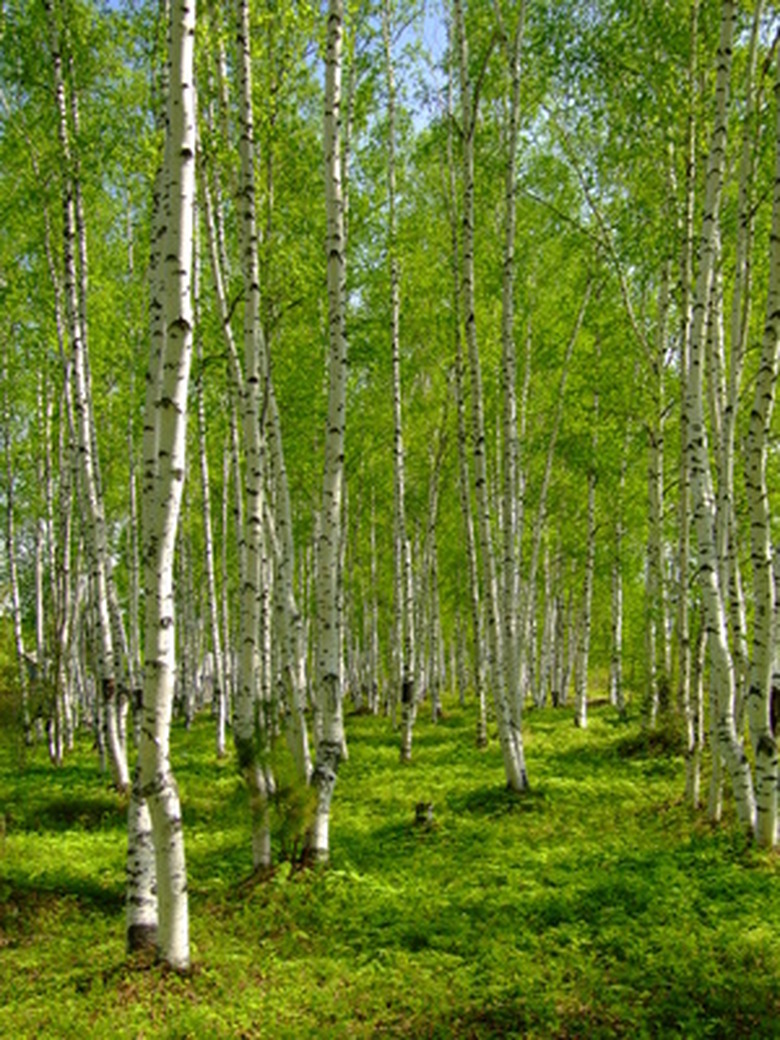Planting Instructions For Birch Trees
Things Needed
- Soil test kit
- Bare root birch tree
- Shovel
- Mulch
- Soaker hose
Paper birch (Betula papyrifera) has stunning white bark, while river birch (Betula nigra) has bark that is reddish black, and the foliage of both turns a vibrant golden yellow in the fall. There are other species of birch available, too. Birch trees can make a decorative addition to your home landscape, but they do require some special attention. Choosing a good location for your birch tree will help ensure success.
Step 1
Evaluate the moisture content of your yard. Birch trees cannot tolerate drought, so they should be planted in locations that receive adequate moisture. Near a creek or pond or even in a low-lying spot that floods in the spring is ideal.
- Paper birch (Betula papyrifera) has stunning white bark, while river birch (Betula nigra) has bark that is reddish black, and the foliage of both turns a vibrant golden yellow in the fall.
- Birch trees can make a decorative addition to your home landscape, but they do require some special attention.
Step 2
Find a spot that receives indirect sunlight all day. In the wild, birch trees often grow in open, lightly shaded forests. While birch trees need some sunlight on their leaves for proper development, too much sun can damage them. In the home landscape, birch trees usually perform best when planted on the north or east side of the house.
Step 3
Test the pH of the soil. Birch trees prefer a slightly acidic soil with a pH between 5.0 and 6.5, although they will tolerate neutral or slightly alkaline soil. Soil test kits can be found at many garden centers, or from you local extension office.
- Find a spot that receives indirect sunlight all day.
- In the home landscape, birch trees usually perform best when planted on the north or east side of the house.
Step 4
Purchase a bare root birch tree. Bare root trees are sold when they are dormant, and although they look like little more than a stick with roots, they tend to transplant better than potted or balled and burlapped trees. Bare root trees are normally sold in the very early spring. Look for bare root birch trees with pliable stems and moist roots. Any garden center that sells trees should stock birch trees.
Step 5
Dig a hole that is as deep as the root ball and twice as wide, and build a small mound in the middle to spread the roots over. Backfill with the excavated soil, and water thoroughly.
- Purchase a bare root birch tree.
- Bare root trees are sold when they are dormant, and although they look like little more than a stick with roots, they tend to transplant better than potted or balled and burlapped trees.
Step 6
Spread 2 to 4 inches of mulch, such as wood chips or shredded bark, in a 3-foot diameter around the base of the birch tree. Leave a space of a few inches near the trunk so the bark can breath. Mulch will help keep the soil cool in the summer, retain moisture and keep down weeds. Replace mulch yearly or as needed.
Step 7
Water your birch deeply once a week during the growing season. Lay down a soaker hose around the base of the tree and let the water slowly seep into the ground for two to three hours to make sure enough water gets down to the root system.
Tip
Birch trees are native to northern North America and Europe, and they will grow best in areas that are cool and moist and where the winter temperatures are below freezing for several months. You won't have much luck trying to grow birch trees in Arizona.
Warning
Birch trees can reach 50 feet tall when mature, and they should not be planted under electrical wires.
